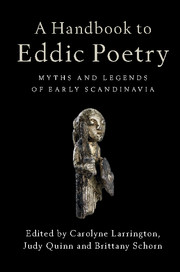Book contents
- Frontmatter
- Contents
- List of illustrations
- List of contributors
- Translations and abbreviations of the titles of eddic poems
- Introduction
- 1 The transmission and preservation of eddic poetry
- 2 Traditions of eddic scholarship
- 3 The editing of eddic poetry
- 4 The dating of eddic poetry
- 5 Eddic performance and eddic audiences
- 6 Eddic poetry and mythology
- 7 Eddic poetry and the religion of pre-Christian Scandinavia
- 8 Eddic poetry and heroic legend
- 9 Place names in eddic poetry
- 10 Eddic poetry and the imagery of stone monuments
- 11 Eddic poetry and archaeology
- 12 Eddic modes and genres
- 13 Eddic metres
- 14 Eddic style
- 15 Kennings and other forms of figurative language in eddic poetry
- 16 Alliterative lexical collocations in eddic poetry
- 17 The representation of gender in eddic poetry
- 18 The reception of eddic poetry
- Consolidated bibliography
- Index
15 - Kennings and other forms of figurative language in eddic poetry
Published online by Cambridge University Press: 05 August 2016
- Frontmatter
- Contents
- List of illustrations
- List of contributors
- Translations and abbreviations of the titles of eddic poems
- Introduction
- 1 The transmission and preservation of eddic poetry
- 2 Traditions of eddic scholarship
- 3 The editing of eddic poetry
- 4 The dating of eddic poetry
- 5 Eddic performance and eddic audiences
- 6 Eddic poetry and mythology
- 7 Eddic poetry and the religion of pre-Christian Scandinavia
- 8 Eddic poetry and heroic legend
- 9 Place names in eddic poetry
- 10 Eddic poetry and the imagery of stone monuments
- 11 Eddic poetry and archaeology
- 12 Eddic modes and genres
- 13 Eddic metres
- 14 Eddic style
- 15 Kennings and other forms of figurative language in eddic poetry
- 16 Alliterative lexical collocations in eddic poetry
- 17 The representation of gender in eddic poetry
- 18 The reception of eddic poetry
- Consolidated bibliography
- Index
Summary
The kenning, a poetic circumlocution comprised of two or more nouns, is usually associated with skaldic praise poetry in dróttkvætt metre, where the kenning's lexical complexity and its allusive power – invoking the grand narratives of myths – could enhance a poet's tribute to his aristocratic patron. Thus, the death-toll arising from Hákon jarl Sigurðarson's military campaigns is celebrated in Tindr Hallkelsson's Hákonardrápa (Drápa of Hákon) by means of the description of the jarl generously providing food – the corpses of his enemy – to the geese of Yggr (a poetic name, or heiti, for the god Óðinn, his ‘geese’ being his carrion-loving ravens): Yggs … gnótt … veitti gǫglum (SkP I, 8/2–3). The usual terminology for describing kennings is by head-word (here ‘geese’), determinant (‘Yggr’), and consequent referent (‘ravens’). The jarl's fame, the poet proclaims, will last as long as people inhabit the earth, which is itself denoted by the kenning Þriðja man, ‘Þriði's girl’ (Þriði is another heiti for Óðinn), whose referent is the god's quondam lover, the giantess Jǫrð, a figure whose name also serves as the common noun for ‘earth’. Through this densely woven verse, something of the grandeur of the god Óðinn rubs off on Hákon: the god's enthusiasm for battle and for subjugating those who threaten him resonates through the choice of determinant in each case, Hákon's territory standing synecdochally for the natural world seen through the lens of Old Norse mythology. At the same time, Tindr's construction of kennings meets the complex requirements of assonance (hendingar) and alliteration in the metre he composed in, a feat which redounded well on his reputation as well as conferring prestige on his patron. Not infrequently, poets also deployed kennings to effect their own self-aggrandisement: the poet Kormákr Ǫgmundarson, for instance, referred to his shield as the ‘foot-platform of the giant Hrungnir’ (Hrungnis fóta stalli), thereby rhetorically wielding in his defence a giant's shield.
The extant corpus of Old Norse poetry creates the impression of a correlation between the use of kennings and verse-forms involving assonance such that it is often deduced that instances of kenning use in eddic metres were the result of skaldic influence.
- Type
- Chapter
- Information
- A Handbook to Eddic PoetryMyths and Legends of Early Scandinavia, pp. 288 - 309Publisher: Cambridge University PressPrint publication year: 2016
- 1
- Cited by

